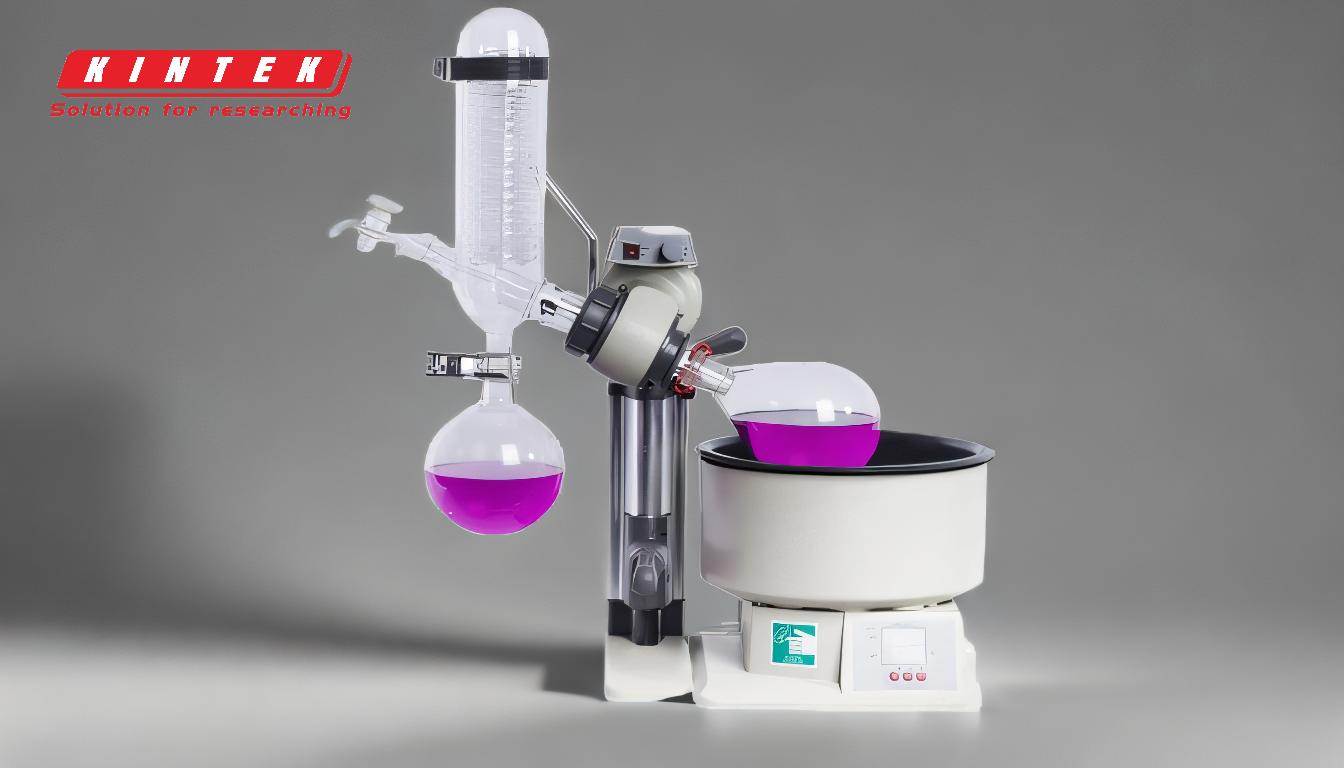The vacuum in a rotary evaporator serves multiple critical purposes, primarily aimed at facilitating efficient and safe solvent removal. By reducing the pressure inside the system, the vacuum lowers the boiling point of the solvent, allowing it to evaporate at lower temperatures. This not only prevents thermal degradation of heat-sensitive compounds but also enhances the separation of solvents from the desired compounds. Additionally, the vacuum system ensures that volatile vapors are contained within the system, minimizing environmental and safety hazards. The controlled pressure environment is achieved through a vacuum pump and regulated by a stopcock, enabling precise operation and ventilation after solvent removal.
Key Points Explained:

-
Lowering the Boiling Point of Solvents
- The vacuum reduces the pressure inside the rotary evaporator, which directly lowers the boiling point of the solvent.
- This allows solvents to evaporate at much lower temperatures than they would under normal atmospheric pressure.
- For example, water boils at 100°C at 1 atm, but under reduced pressure, it can boil at temperatures as low as 40°C or less.
- This feature is particularly beneficial for heat-sensitive compounds that may degrade at higher temperatures.
-
Efficient Separation of Solvents from Compounds
- By lowering the boiling point, the vacuum enables the selective evaporation of solvents while preserving the integrity of the target compounds.
- This separation is critical in processes like purification, concentration, or isolation of compounds in chemistry, pharmaceuticals, and food science.
- The controlled evaporation ensures that the desired product remains unaffected by excessive heat or harsh conditions.
-
Prevention of Volatile Vapor Release
- The vacuum system creates an airtight environment, preventing volatile solvents from escaping into the atmosphere.
- This containment is essential for safety, as many solvents are flammable, toxic, or harmful to the environment.
- It also ensures compliance with laboratory safety regulations and minimizes exposure risks to operators.
-
Energy Efficiency and Preservation of Sample Integrity
- By operating at lower temperatures, the vacuum reduces the need for excessive heat, which saves energy and minimizes thermal stress on the sample.
- This is particularly important in applications like flavor extraction, where maintaining the natural properties of the sample is crucial.
- The gentle evaporation process helps preserve the chemical structure, flavor, and aroma of sensitive materials.
-
Control and Regulation of the Vacuum System
- The vacuum is controlled using a stopcock, typically located at the highest point of the condenser.
- This allows precise adjustment of the pressure within the system, enabling optimal evaporation rates and separation efficiency.
- After the solvent removal process, the stopcock is used to ventilate the system, restoring normal pressure and allowing safe handling of the apparatus.
-
Enhanced Distillation Efficiency
- The vacuum pump works in conjunction with the condenser to ensure efficient trapping and re-liquefaction of vaporized gases.
- By increasing air pressure in the condenser, the vacuum slows down the movement of gases, improving the condensation process.
- This results in higher recovery rates of solvents and reduces the likelihood of sample loss.
-
Versatility in Applications
- The vacuum system makes rotary evaporators suitable for a wide range of applications, including solvent recycling, essential oil extraction, and chemical synthesis.
- Its ability to handle low-boiling-point compounds and heat-sensitive materials expands its utility across industries.
In summary, the vacuum in a rotary evaporator is indispensable for achieving efficient, safe, and precise solvent removal. It enables lower-temperature evaporation, protects sensitive compounds, ensures safety by containing volatile vapors, and enhances overall distillation efficiency. These features make the vacuum system a cornerstone of rotary evaporation technology, catering to diverse scientific and industrial needs.
Summary Table:
| Key Purpose | Benefits |
|---|---|
| Lowering Boiling Points | Enables evaporation at lower temperatures, protecting heat-sensitive compounds. |
| Efficient Solvent Separation | Preserves target compound integrity during purification and concentration. |
| Volatile Vapor Containment | Prevents release of harmful vapors, ensuring safety and compliance. |
| Energy Efficiency | Reduces thermal stress on samples, saving energy and preserving properties. |
| Precise Vacuum Control | Allows optimal evaporation rates and safe system ventilation. |
| Enhanced Distillation Efficiency | Improves solvent recovery and reduces sample loss. |
| Versatile Applications | Suitable for solvent recycling, essential oil extraction, and more. |
Discover how a rotary evaporator can optimize your lab processes—contact our experts today!










